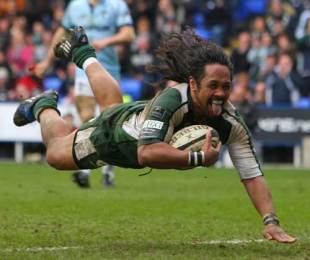|
Rugby Primer
Running and Tries
Scrum.com

© Getty Images
Enlarge
If and when the ball is produced from a ruck or maul without penalty, usually by the scrum-half, the ball will most often be passed to a forward charging back through the defence or to the fly-half who has pre-determined a course of action. The fly-half is the person normally determining all moves which the backs will run. Once he has received the ball he will then start a run, make a pass, or kick the ball. All of this must be done very quickly as the opposing backs and forwards will be quickly rushing up to tackle whomever has the ball. The moves the backs run will include a number of different manoeuvres and ploys to put the backs into open running space. Common running tactics include loops, switches, dummies, and miss passes. A loop is where a player will make a short pass to another and then run around to the other side of that player to receive a return pass. A switch is where two players will cross paths allowing the ball carrier to pass behind himself to a runner running on a different angle. A dummy is a faked pass to another runner freezing or decoying the defender. A dummy switch is a switch where the ball carrier does not pass the ball to the crossing runner. A miss pass is a pass which is thrown past the first immediately available supporting player to runners further past him. When the ball is being run, a player tackled to the ground must immediately release the ball (the defender tackling the runner must release the runner after the tackle) making it available to both teams. Typically the tackled player will attempt to place the ball closest to his own supporting players. Those supporting players will make a decision to pickup the loose ball or drive over the ball and tackled player to bind together into a new ruck. The defending team will do the same thing in an attempt to push the attacking team backwards. If the ball is picked up and advanced again by either side, a maul can quickly ensue if the advance is checked by the defence and the ball does not go to the ground. Each time a successive ruck or maul is set, it is described as a phase of play. Once a player makes a break over the tryline, he must touch the ball down to the ground to be awarded the 5 points for the try. If he loses the ball in the dead ball area, the ball will come out and play will be restarted with a 22 metre dropout. Often a player will cross the tryline close to one of the touchlines and will turn back towards the posts before touching down. This is done to provide a better angle for the person attempting the conversion kick. The kick for extra points must be taken from a mark perpendicular to the spot where the try was touched down. Thus the kicker's job is typically made much easier when the try is awarded centered between the posts. The conversion kick is a place kick taken immediately after the try and worth 2 points. The defending team must retreat behind the tryline but can rush the kick once the kicker makes a move towards the ball to kick it through the uprights. © Scrum.com
|
Live Sports
Communication error please reload the page.
-
Football
-
Cricket
-
Rugby
-
- Days
- Hrs
- Mins
- Secs
F1 - Abu Dhabi GP
Abu Dhabi Grand Prix December 11-131. Max Verstappen ()
2. Valtteri Bottas (Mercedes)
3. Lewis Hamilton (Mercedes)
4. Alexander Albon ()
5. Lando Norris ()
6. Carlos Sainz Jr ()
-
ESPNOtherLive >>
Boxing - Nelson v Wilson; Simmons v Dickinson; Joshua v Gavern (Metro Radio Arena, Newcastle)
Golf - Houston Open
Snooker - China Open
Tennis - Miami Open

